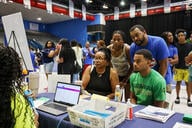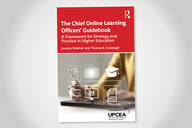You have /5 articles left.
Sign up for a free account or log in.
Perhaps the most important document that we should read and discuss on campus says nothing at all about higher ed.
It is the leaked 96 page New York Times Innovation report, called Strengthening Our Newsroom: Digital First, written by 10 Times employees.
From what I can tell the Times has not published the report on its website, or released it in an easy to ready e-book format. This is a shame, as the report demonstrates a company culture that is secure and resilient enough to critique its own organizational structure and honest enough own up to some critical weaknesses and shortcomings. Releasing the report would have been the smartest thing to do in the face of the Jill Abramson firing and the leadership shuffle at the paper.
The authors of the report argue that the Times is failing in its mission to serve its readers because it has not embraced the potential of digital platforms. That the print first culture and organizational structure at the Times has resulted in digital journalism being a “bolt on” to a paper driven organizational structure. That the world’s best journalism is only one part of the equation, as journalism that does not reach a critical mass of citizens due to a failure to embrace digital platforms and to practice best digital practices will ultimately have little positive social impact.
We can argue about both the diagnosis and the recommendations found in the Times Innovation Report.
What I am more interested in hearing from you is what you think the report can teach us in higher ed.
I was struck by the similar challenges that both the Times and much of higher ed will have in leveraging digital platforms and digital best practices to meet our missions.
Very few of our institutions were born digital. We have a campus and classroom orientation, and we are struggling to understand how we can leverage digital tools and methods to enhance learning and research, while simultaneously addressing pressing issues around costs, revenues, and access.
One of the major recommendations of the report is that the NYTimes should move to more of a team approach when it comes to producing journalism. That today, reporters and editors and digital producers and designers and audience engagement specialists are siloed. That the focus is on creating the highest quality journalism (getting to Page One), and the planning and evaluating for having maximum reach and impact around that reporting is seen as either someone else's job, and is therefore not given the systematic thought and planning that it requires.
The report notes that the divide between the journalistic and digital sides of the organization is frustrating for the digital professionals. The reason that many people come to work at the Times is to be part of the journalistic mission, and the inability to collaborate closely with reporters and editors causes many of the most talented professionals to leave.
The parallels with how both journalism and higher education are changing are enlightening. Like journalism, the platforms in which teaching and learning occur have greatly multiplied.
For the Times, this means that the print newspaper is amongst one of many places that readers may interact with the journalism. Other places include mobile platforms, the Web, social media, e-books, and even live events.
In higher ed, the places where learning occurs have been greatly expanded beyond the campus, the classroom, the lab, and the library.
Today, students can interact with faculty, fellow students, and our curriculum from anywhere and at anytime. The physical campus is no less important (in fact it may be more important), but the physical campus can be extended and better utilized with the addition of a range of digital tools and new practices.
Like the NYTimes, it has been a challenge for much of higher ed to change our organizational structures rapidly enough to take advantage of the opportunities for mission advancement that have been presented by the digital revolution.
Just as the Times Innovation Report suggests that journalism has become a team sport (pairing reporters, editors, and digital experts), many aspects of teaching and learning could be improved with a similar collaborative approach.
Rethinking traditional large enrollment introductory lecture classes, with perhaps more of an emphasis on active learning and a blended delivery structure, will require instructors to team up with instructional designers and other non-faculty educators. There is little doubt that online learning, whether small low-residency or fully online degree programs or full open online courses, require a partnership between faculty and a range of digital learning experts. These partnerships between faculty and non-faculty educators will also be essential as teaching in larger enrollment classes move to a more blended model of instruction.
The report is unflinching in reporting on the barriers in the NYTimes organizational structure in creating a nimble, flexible, risk taking, and collaborative culture.
How many strategic higher ed reports would be brave enough to turn the same sort of critical lens internally as we see with the Times Innovation Report?
The real lessons for higher ed in the Times report will not be found in the report’s specific recommendations. Rather, the real lesson is the value of being unafraid to take advantage of this digital moment to ask some fundamental questions about how our work is organized to meet our larger mission.
Is the report being read and discussed on your campus?
What parallels between the Times and your institution did you find in reading the report?




